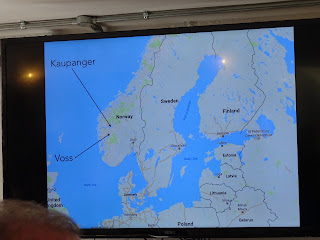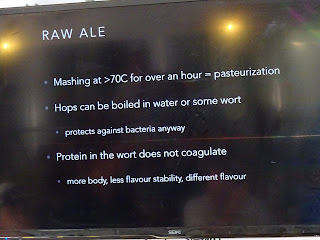Beer = Grain + Work
Farmhouse brewing goes back thousands of years and wherever people grow grains (rice, maize, barley...) they make beer.
So all of northern Europe should have farmhouse brewing traditions. Farmhouse ales would be found everywhere (except where wine can be made!).
It wasn't commercial brewing as everyone made it. Hops are a preservative so helped commercial beer to spread.
Craft, Industrial and Home brewing are one branch of beer history that is distinct from farm ales. The only technological advances in farm brewing have been metal vessels and hose pipes.
 |
| Four and a half years ago |
The brewer was taught how to make traditional beer for his wedding in 1992. Norwegian farmhouse breweries are generally based on 150 litres as barrels were 144.
A fire is started to heat water to 80°C and make juniper tea. They split the branches lengthwise.
They mash at 72°C for two hours.
Wort separation is problematic so he puts a wire mesh on top of the branches and runs off slowly (25hl/hr)
He doesn't know what hops he uses.
The beer has no hop character anyway.
Juniper is the spice, not hops, so the beer has lots of juniper flavour and bitterness from the juniper.
The beer has a smoky, banana flavour, is 8-9% ABV and only 7 or so IBU.
Voss is 1000 km south.
It is not near the sea so was very isolated until the 1950s.
The wort is boiled for six hours, giving 50% evaporation. The wort darkens considerably!
 |
| Insects leave branches one or two days after they're picked. |
The beer tastes of yeast and like and explosion in a marmalade factory!
The yeast is stored in the fridge for four to six months. It can generally be traced back to grandpa at best.
The yeast used to be dried on wooden rings for storage. Fermentation still starts in four hours!
The fermenter is insulated. They yeast is pitched at 39°C and rises to 43°C.
Sigmund's yeast is three strains, all Saccharomyces cerevisiae.
Hornindal is also isolated, this time by a glacier.
The yeast is dried in flakes and bacteria are present, but the species is unknown.
The beer is not sour. It has flavour of tropical fruit, milky, mushroom and caramel.
They good flavour came when the yeast and bacteria were used.
They mash at 74°C and don't boil the wort.
The yeast is pitched at 30°C.
It gets going quickly as the brew is made on Saturday and a party is held on Monday evening!
No boil so no protein coagulation and no hops either. This give it a characteristic flavour.
I once made a 'malta' (unfermented beer) without boiling and when it went for testing Lactobacillus were found in it, so it's certainly possible for microorganisms to survive mashing.
 |
| Can't remember what was going on here |
Next stop was Lithuania. Farmhouse brewers in Northern Lithuania mash with water not juniper infusion.
They mash at 67°C, adding boiling water and grain until the mash paddle can't stand up.
After an hour the mash is put in an oven for three hours, where it boils and the sugar caramelises (tastes like honey!).
It's filtered with wooden chips and straw. 100% pale malt but the beer is dark. It's fermented with baker's yeast.
Until 1850 you had to have your own yeast, mostly S.cerevisae, although one farm brewery used Brettanomyces. All are multi-strain.
Kveik is very distinct from commercial yeast, and kveiks are split between those used in boiled and raw ales.
Kveik is domesticated. It is very thermotolerant and can be dried. The tropical fruit flavours they make can mean it tastes like you're drinking something made with American hops.
In Chuvashia (I think!) they call the yeast Gong, but sadly they don't brew in flying teapots.
The yeast is mixed with wort, sugar and white flour. They ferment at 39°C.
Kveiks are not POF+ (i.e. they don't produce phenolic flavour), other strange yeasts are. In North Lithuania where they brew more often than in Norway the yeasts are not drying resistant.
Farm brewing was carried out in Suffolk up until the 1950s.
Hot water was added in steps, which is a safer way to get the temperature right when you don't have a thermometer.
Yeast was shared around the village in a chain, like a ginger beer plant.
Farmhouse ales are the bigger half of brewing, in every details except volume!
It's a simple process that anyone can do, farmhouse brewers are not worried about details.
My notes end on "boiled wort came with metal kettles", which presumably was an answer to a question. And that ends my write up of Lars' excellent talk, which given the topic I can just squeeze into The Session #136, as the topic fits and I've been told I can get away with being a few days late.






























































Well put Ed. My contribution to the Session omits this dimension simply due to its invisibility in the market, or non-commercial nature. Those I encounter in the market described as farmhouse fit the bill I described including two recently tasted in England.
ReplyDeleteGary Gillman
Www.beeretseq.com
Thank you! I was really hoping you'd do this, having seen some of your talk writeups in the past. I'll hope you forgive me adding some corrections.
ReplyDeleteVoss is about 100km south, not 1000.
It was the liquid on top of the yeast in that glass jar which had the explosive taste, not the beer itself.
The Chuvash for yeast is "chepche" (specifically meaning bottom yeast). "Gong" is Hallingdal, eastern Norway.
Thanks Lars, I did have trouble writing up my notes in places so any corrections are more than welcome.
DeleteThis comment has been removed by the author.
ReplyDelete